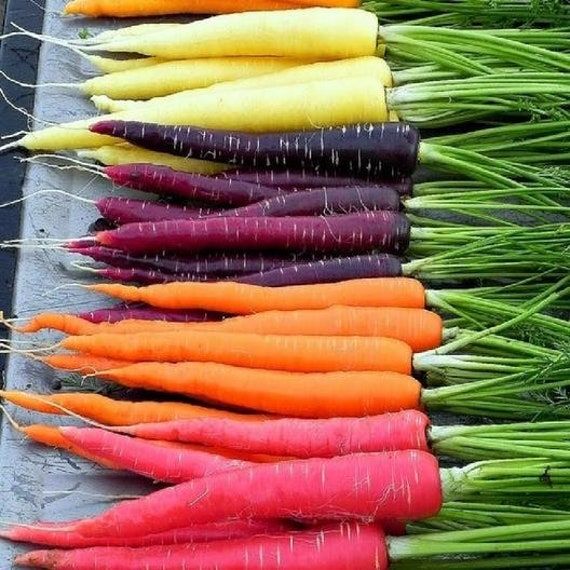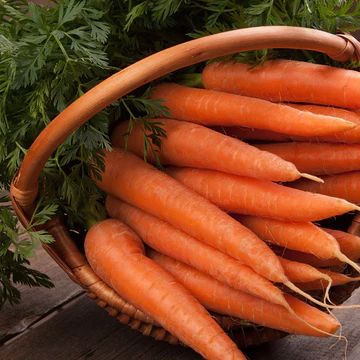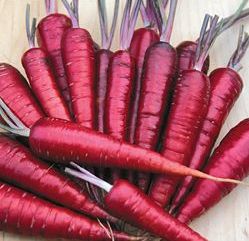
Among the popular and versatile root vegetables that are appreciated worldwide for sweet flavor, crunch texture, and bright colors is carrots or Daucus carota subsp. sativus. Being grown on nearly all lands, these can come in a most astonishing range of types with differing characteristics that are valuable knowledge to understand for the serious gardener and cook and the consumer as well, if interested in reaping all potential that these nutritious vegetables provide. Here we describes different types of carrots.
General Categories of Carrots
Carrots can be classified based on their shape, size, and color. The primary types include.
Shape and Size:
There are five types of carrots with there size and shapes.
Imperator Carrots.

Imperator carrots are the last long, skinny carrots found in most supermarkets. Their skin is smooth and shiny, tapering at one end, with a sweet, crisp flavor. They seem to grow about 8-12 inches long and would really like deep, loose soil to accommodate their straight-growing roots. Imperator is an excellent variety for fresh eating, juicing, and cooking.
Full sun with consistent moisture creates their own sweetness. For instance, Sugarsnax and Imperial are high-beta-carotene varieties. Most of us want to use sweet, bright-colored, traditionally shaped carrots-they simply grow up a great deal better, so much easier.
Danvers Carrots

Danvers carrots are a long-standing, very versatile kind of carrot variety, generally medium in length, and conical, with the strongest earthy flavor. Being 6–8 inches long, tapering at the point, Danvers is perfect for various uses: boiling, stewing, pickling, and more. Danvers is also widely preferred because they adapt exceptionally well to a wide variety of soils, including the heavy, clay, and less-than-ideal soils many other varieties may not succeed in. They resist cracking, thus ensuring consistent harvests.
This carrot variety was originally developed in Danvers, Massachusetts, and is valued for its deep color and firm texture. Danvers carrots take approximately 70–80 days to mature and grow best in full sun with adequate moisture. While they are not as sweet as some varieties, such as Nantes or Imperator, their flavor is hearty, making them ideal for cooking, soups, stews, and canning.
The Danvers Half Long variety is specifically in great demand due to its smaller size, which means it is ideal for small garden spaces. Overall, Danvers carrots are a favorite of gardeners seeking a hardy and reliable carrot variety.
Chantenay Carrots

Chantenay carrots grow short and stout, a broadly shaped root, reaching just about 5–6 inches in length. Due to their compact size, the carrots grow well in rather shallow soils, with very rocky or clayey surfaces where other longer carrots can be hard-pressed to develop properly. Chantenay carrots can also be distinguished easily by their striking orange color and conical end tapering to a tip.
The following carrots are highly prized for their sweet earthy flavour and firm texture, make excellent cooking and roasting, juicing and storage. They also resist the cracks of other types more commonly, as they also carry a higher moisture level inside them.
Chantenay carrots are grown well in cooler climates and are usually harvested late summer or fall. Among the popular varieties is the Red Cored Chantenay, which has a striking red core and robust taste. Chantenay carrots are a reliable, hardy option for both gardeners and culinary enthusiasts.
Nantes Carrots

Nantes carrots are a popular variety, grown for their cylindrical shape with a smooth surface, blunt tip, and sweet, tender flavor. They are normally around 6–7 inches long and have a great vibrant orange color. They have a great crisp texture with very little core, making them perfect for fresh eating, juicing, and cooking. They are particularly sweet, and their appeal is especially to children and used in salads or as a healthy snack.
Nantes carrots do best in loose, sandy, or very well-draining soils. In these conditions, the roots can grow straight and long without any obstruction. It matures pretty fast, within 60 to 70 days of planting, and it’s less prone to cracking as in other varieties of carrots.
Some popular varieties are Scarlet Nantes and Nantes Coreless, known for their uniformity and flavour. Because of their versatility and reliability, Nantes carrots are an essential crop for both home gardeners and market growers.
Color Variations
Indeed, color is not limited to orange or yellow; carrots come in purple, yellow, red, and white shades, each with their health benefits: antioxidants in the purple, lycopene in the red, and lutein in the yellow.
Orange Carrots

Orange carrots are the most common variety, high in beta-carotene, which converts to vitamin A and supports eye health and immunity. Sweet and versatile, they are ideal for fresh eating, cooking, juicing, and adding vibrant color to dishes.
Purple carrots

Purple carrots are quite vibrant, full of anthocyanins, which are the powerful antioxidants that help heart health and reduce inflammation. Often orange on the inside, they offer a sweet flavor with a slightly spicy taste. Perfect for fresh eating, salads, and juicing, they enhance both nutrition and presentation.
Red Carrots

Red carrots are an unique variety. They owe their color to lycopene, which is a powerful antioxidant connected to heart health and preventing cancer. Carrots with such color are sweet-tasting like the orange ones but have an earthy flavor. Generally, they require similar conditions to other types. Red carrots are grown under conditions of full sunlight and in well-drained soil. They are rich in vitamins, fiber, and antioxidants, which provides a myriad of health benefits. They have popular varieties such as Atomic Red that are often used for cooking, juicing, and salads to add color and nutritional value to any dish.
Yellow carrots

Yellow carrots are sweet and mild. They have a sunny color that just brightens up any dish. They are rich in lutein, an antioxidant which is good for eye health. Popular in salads, roasting, and snacking, varieties like Yellowstone are valued for their vibrant hue and unique nutritional profile.
White Carrots

White carrots taste milder and less sugary than other varieties because they are less sweet but have a lot of potential for soups, stews, and puree. They do not carry pigments like beta-carotene but are fibrous and full of nutrient. Some varieties, such as White Satin, provide a creamy color on the plate that is softly elegant.
good